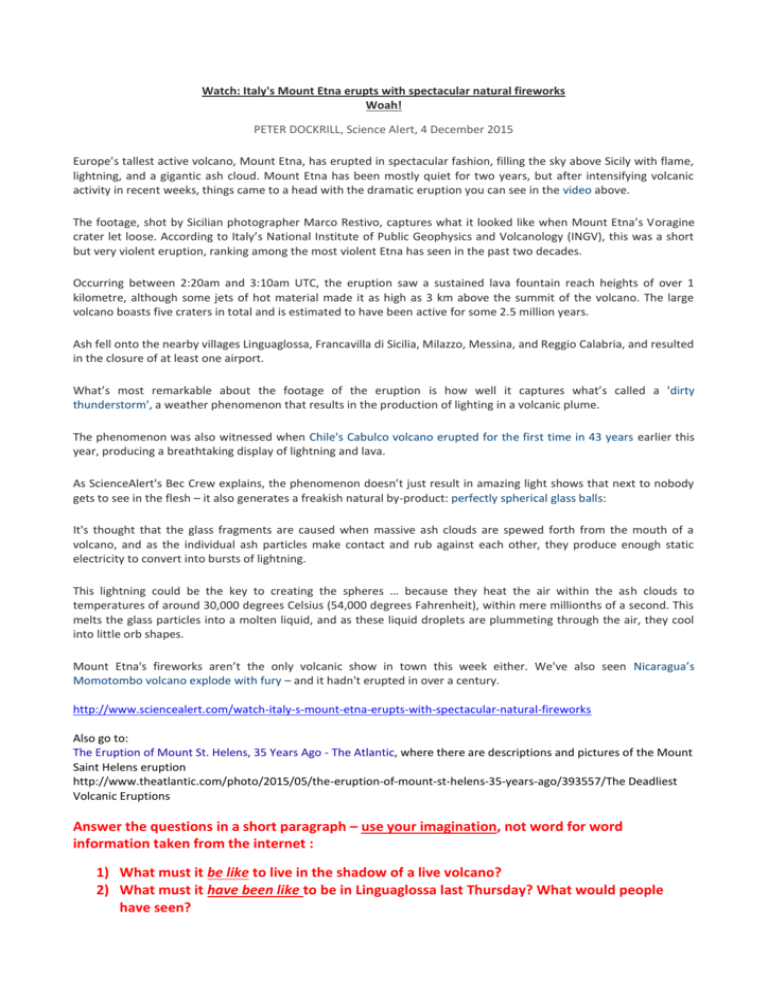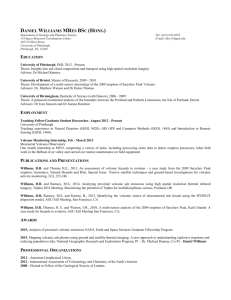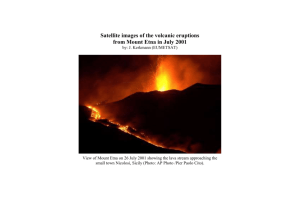Europe`s tallest active volcano, Mount Etna, has erupted
advertisement

Watch: Italy's Mount Etna erupts with spectacular natural fireworks Woah! PETER DOCKRILL, Science Alert, 4 December 2015 Europe’s tallest active volcano, Mount Etna, has erupted in spectacular fashion, filling the sky above Sicily with flame, lightning, and a gigantic ash cloud. Mount Etna has been mostly quiet for two years, but after intensifying volcanic activity in recent weeks, things came to a head with the dramatic eruption you can see in the video above. The footage, shot by Sicilian photographer Marco Restivo, captures what it looked like when Mount Etna’s Voragine crater let loose. According to Italy’s National Institute of Public Geophysics and Volcanology (INGV), this was a short but very violent eruption, ranking among the most violent Etna has seen in the past two decades. Occurring between 2:20am and 3:10am UTC, the eruption saw a sustained lava fountain reach heights of over 1 kilometre, although some jets of hot material made it as high as 3 km above the summit of the volcano. The large volcano boasts five craters in total and is estimated to have been active for some 2.5 million years. Ash fell onto the nearby villages Linguaglossa, Francavilla di Sicilia, Milazzo, Messina, and Reggio Calabria, and resulted in the closure of at least one airport. What’s most remarkable about the footage of the eruption is how well it captures what’s called a 'dirty thunderstorm', a weather phenomenon that results in the production of lighting in a volcanic plume. The phenomenon was also witnessed when Chile's Cabulco volcano erupted for the first time in 43 years earlier this year, producing a breathtaking display of lightning and lava. As ScienceAlert's Bec Crew explains, the phenomenon doesn’t just result in amazing light shows that next to nobody gets to see in the flesh – it also generates a freakish natural by-product: perfectly spherical glass balls: It's thought that the glass fragments are caused when massive ash clouds are spewed forth from the mouth of a volcano, and as the individual ash particles make contact and rub against each other, they produce enough static electricity to convert into bursts of lightning. This lightning could be the key to creating the spheres … because they heat the air within the ash clouds to temperatures of around 30,000 degrees Celsius (54,000 degrees Fahrenheit), within mere millionths of a second. This melts the glass particles into a molten liquid, and as these liquid droplets are plummeting through the air, they cool into little orb shapes. Mount Etna's fireworks aren’t the only volcanic show in town this week either. We've also seen Nicaragua’s Momotombo volcano explode with fury – and it hadn't erupted in over a century. http://www.sciencealert.com/watch-italy-s-mount-etna-erupts-with-spectacular-natural-fireworks Also go to: The Eruption of Mount St. Helens, 35 Years Ago - The Atlantic, where there are descriptions and pictures of the Mount Saint Helens eruption http://www.theatlantic.com/photo/2015/05/the-eruption-of-mount-st-helens-35-years-ago/393557/The Deadliest Volcanic Eruptions Answer the questions in a short paragraph – use your imagination, not word for word information taken from the internet : 1) What must it be like to live in the shadow of a live volcano? 2) What must it have been like to be in Linguaglossa last Thursday? What would people have seen? For your interest: The following table lists the deadliest volcanic eruptions in the world on record according to name, year, number of deaths, and major cause of deaths. In 1812, Tambora volcano in Indonesia erupted causing 92,000 deaths. Volcano Year Deaths Major cause of deaths Tambora, Indonesia 1815 92000 Starvation Krakatau, Indonesia 1883 36417 Tsunami Mount Pelee, Martinique 1902 29025 Ruiz, Colombia 1985 25000 Mudflows Unzen, Japan 1792 14300 Volcano collapse, tsunami Laki, Iceland 1783 9350 Starvation Kelut, Indonesia 1919 5110 Mudflows Galunggung, Indonesia 1882 4011 Mudflows Vesuvius, Italy 1631 3500 Mudflows, lava flows Vesuvius, Italy 79 Ash flows 3360 Ash flows, falls Papandayan, Indonesia 1772 2957 Ash flows Lamington, Papua New Guinea 1951 2942 Ash flows El Chichon, Mexico 1982 2000 Ash flows Soufriere, St. Vincent 1902 1680 Ash flows Oshima, Japan 1741 1475 Tsunami Asama, Japan 1783 1377 Ash flows, mudflows Taal, Philippines 1911 1335 Ash flows Mayon, Philippines 1814 1200 Mudflows Agung, Indonesia 1963 1184 Ash flows Cotopaxi, Ecuador 1877 1000 Mudflows Pinatubo, Philippines 1991 800 Disease Komagatake, Japan 1640 700 Tsunami Hibok-Hibok, Philippines 1951 500 Ash flows ash fall = a rain of airborne ash resulting from a volcanic eruption, and the deposit produced by such an event ash flow = an avalanche of volcanic ash







